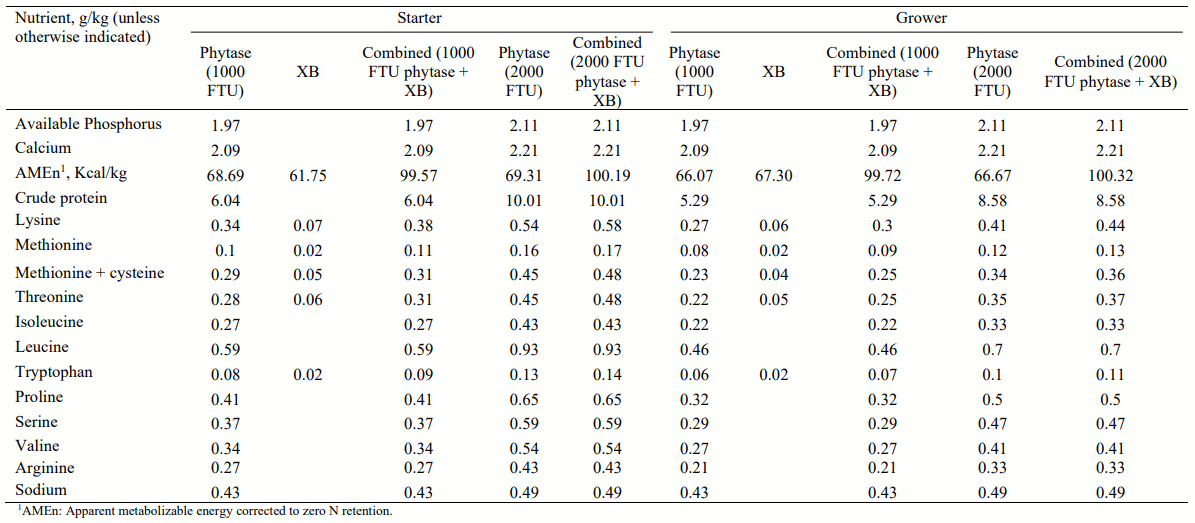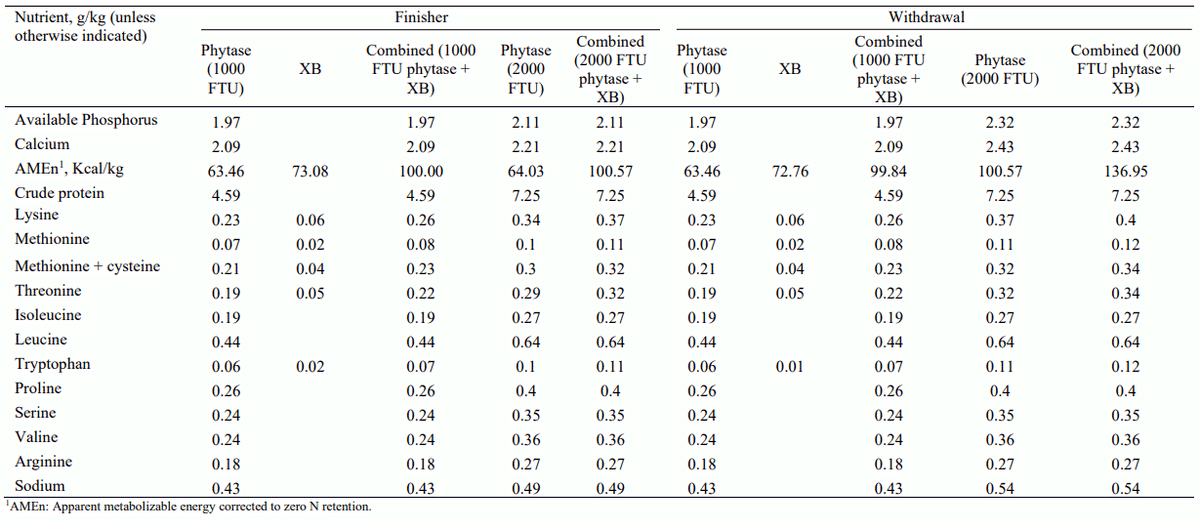I. Introduction
Typical Australian broiler diets contain 2.5-3.0 g/kg phytate-P or roughly 10.0 g/kg phytate; therefore, phytase is included into every Australian broiler diet. As phytase is capable of increasing the availability of phosphorus, calcium, sodium, amino acids and energy content of diets, these nutrients may be decreased in the feed formulations as ‘matrix values’ without adverse effects on the birds’ growth performance (Dersjant-Li et al. 2020). However, phytase inclusion rates and matrix values vary substantially across the industry, and this is further complicated as phytase and NSPase enzymes are typically used in tandem in broiler diets. When used in combination, energy matrix values are applied to the NSPase enzyme rather than to phytase itself, so as not to ‘double up’. It is recommended that, when the enzymes are used in combination, the matrix values should not be applied additively but specifically adjusted based on the levels of the substrate (Adeola and Cowieson 2011). Thus, further study is required to identify matrix values of phytase and in combination with XB at multiple levels to improve adoption of a full matrix by the Australian poultry industry.
Therefore, a trial was conducted at the University of New England to determine if ascribed matrix values for phytase and in combination with XB were appropriate across multiple inclusion levels and combinations.
II. Method
Six treatments were tested including a positive control (PC, T1) formulated meeting Cobb nutritional requirements and 5 test diets reformulated with reduced nutrients and energy according to respective matrix values of the enzymes used. The enzymes supplemented are; T2, a novel consensus bacterial 6- phytase variant (Axtra® PHY Gold, PhyG, Danisco Animal Nutrition) at 1000 FTU/kg; T3, a mixed enzyme (Axtra® XB, XB, Danisco Animal Nutrition, supplemented at 100 g/t to provide 1,220 U/kg xylanase and 152 U/kg beta-glucanase); T4, PhyG at 1000 FTU and XB combination; T5, PhyG at 2000 FTU/kg; T6, a combination of PhyG at 2000 FTU and XB. A total of 912 mixed-sex Cobb 500 birds were randomly assigned to 6 dietary treatments (4 diet phases per treatment) with 8 replicate floor pens per treatment from 0-42 d post-hatch. Sampling was performed at days 21 and 42. Growth performance, organ weights, apparent metabolisable energy, toe ash, and digestibility of Ca, P, Na, protein, starch and NSP were measured. Positive control diets were formulated to Cobb nutrient recommendations and were based on wheat, maize, soybean meal, lupin and canola seed containing high level of phytate and total arabinoxylan. Matrix values were included in the formulation of the test diets, and were ascribed for Av.P, Ca, Na, AME, Lys, Met, Thr, Ile, Leu, Try, Pro, Ser, Val, and Arg as per Danisco Animal Nutrition recommendations (Tables 1 and 2).
Table 1 - In feed contribution values ascribed to phytase and XB inclusions over the starter (d 0 to 10) and grower (d 10 to 21) phases where appropriate.
Table 2 - In feed contribution values ascribed to phytase and xylanase inclusions over the finisher (d 21 to 35) and withdrawal (d 35 to 42) phases where appropriate.
Diets contained the same level of phytate-P and total arabinoxylan and were cold-pelleted at 65°C. Birds had unlimited access to feed and water, and lighting and temperature followed breeder guidelines. The study was approved by the University of New England’s Animal Ethics Committee (AEC20-049). The data were analysed via an ANCOVA, with room and % males per pen as covariates. Pen was considered the experimental unit and statistical significance was established at P ≤ 0.05. Pairwise comparisons were made via Fisher’s LSD.
III. Results
Despite the application of full matrix specifications to both phytase and XB, many parameters such as weight gain, FCR, and the ileal digestibility of Ca, P, starch and protein were either not significantly different or significantly improved by dietary treatments in comparison to the PC diet (with the exception of treatment 2 for ileal P digestibility). Over the entire experimental period (d 0 to 42), phytase inclusion at 2000 FTU/kg numerically increased BWG by 3.07% compared to the PC diet (3087 g/bird versus 2995 g/bird). Similarly, 2000 FTU phytase and XB in combination numerically increased BWG by 2.91% compared to the PC diet (3081 g/bird versus 2995 g/bird). Also, phytase inclusion at both levels (1000 or 2000 FTU/kg) increased BWG from d 0 to 10 (P < 0.05) and d 10 to 21 (P < 0.05) compared to the PC diet by pairwise comparisons. Thus, the enzymes successfully released the nutrients and energy that the diets were reduced by in the inclusion of the ascribed matrix values.
IV. Discussion
Given that the full matrix value reductions implemented in diets with phytase and XB inclusions were sizeable, it is noteworthy that the birds offered these diets had similar feed efficiency in all feeding phases and similar ileal digestibility of protein, starch, calcium and phosphorus at d 21 compared to the PC diets in the current study. Furthermore, despite the application of full matrix specifications, phytase inclusion at both 1000 and 2000 FTU/kg increased BWG in starter and grower phases. The results of the current work support those previously reported in the literature (Amerah et al. 2014; Truong et al. 2017; Gilani et al. 2021) and suggest that phytase and XB successfully released the nutrients and energy that the diets were reduced by in the inclusion of the matrix values. Overall, it may be concluded that these matrix values are appropriate, and may even generate an improved body weight gain.
ACKNOWLEDGEMENTS: The authors would like to acknowledge and thank Danisco Animal Nutrition (IFF) for funding this project and for their encouragement and support.
Presented at the 33th Annual Australian Poultry Science Symposium 2022. For information on the next edition, click here. 














.jpg&w=3840&q=75)